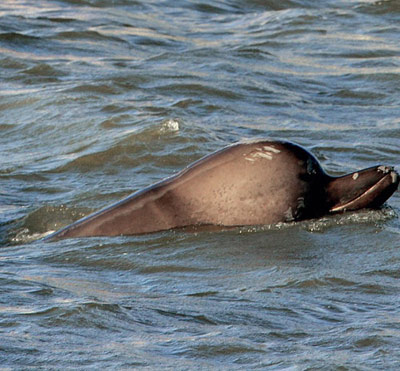|
Whale in River Thames causes a wave
(AP)
Updated: 2006-01-21 09:02
It's a whale of a tale — a bottle-nosed whale swimming up the River Thames
past Big Ben and Parliament on Friday as rows of worried Londoners looked on.
The whale was spotted in the afternoon as it flailed
around in the murky waters of the Thames, stirring up patches of what looked
like blood as seagulls hovered above and rescue boats stood at the ready. It was
the first sighting of a Northern bottle-nosed whale in the river since British
whale-watching records began in 1913.

A Northern
Bottle-nosed Whale pokes its head out of the river Thames near Battersea
Bridge in south London January 20, 2006. The small whale swam up the
Thames to central London on Friday, a rare event which drew large crowds
of sightseers and brought traffic to a standstill.
[Reuters] |
Witness Tom Howard-Vyne said he saw the mammal swim under Westminster Bridge,
near Big Ben. "I saw it blow. It was a spout of water which sparkled in the
air," said Howard-Vyne. "It was an amazing sight."
Other witnesses reported seeing a second whale in another part of the river
Friday, and marine experts spotted two disoriented whales off northeastern
Scotland last week, suggesting something was causing bottle-nosed whales to
become confused.
"It is a race against time to save the animal," said Alison Shaw, marine and
freshwater conservation program manager at the Zoological Society of London.
A small armada of rescue boats frantically searched for the mammal, but it
was lost from view around sunset, when it dived under water.
Crews barricaded a section of river in an attempt to force the animal to
change course; it was unclear if their efforts were a success.
"A whale in the shallow water of the River Thames is like a human lost in the
heat of the Sahara desert. It's just not made for these conditions," said Laila
Sadler, scientific officer at the Royal Society for the Prevention of Cruelty to
Animals.
"We are worried that it will survive only for 24 to 48 hours if it doesn't
head back to sea. It also seems to be in distress, it has already made two
seemingly deliberate attempts to beach itself."
A rescue boat equipped with a cradle is on standby in case the creature
beaches itself and another is fitted with a net, which could be used to drag the
animal downriver.
Witnesses reported seeing injuries to the whale — which was an estimated 17
feet long — and said its snout was bloodied. Photos also appeared to show damage
to one of the whale's eyes and a number of cuts to its torso, though Sadler said
these are not uncommon.
Several onlookers jumped into the 48-degree water, splashing to try to coax
the mammal away from shore. Members of the Whale Watch conservation group also
ferried across the river to assess its condition.
Bottle-nosed whales normally live in the northern Atlantic, diving deeply and
traveling in pods. They can reach 26 feet long — the size of a red double-decker
London bus.
When sick, old or injured, whales often get disoriented and swim away from
their pod, said Mark Simmonds, science director at Whale and Dolphin
Conservation Society.
Last week, marine officials said they saw two bottle-nosed whales in
northeastern Scotland when the mammals are normally seen in northwestern
Scotland. That, coupled with the sighting Friday of a second whale in a
different part of the Thames, could suggest that something is disrupting the
whales, said Laila Sadler, scientific officer at the Royal Society for the
Prevention of Cruelty to Animals.
There are many possible reasons whales become disoriented. Scientists have
said fluctuating ocean temperatures, predators, lack of food and even sonar from
ships can send them into waters that threaten their survival.
"It's used to using acoustics to find its way around. What will happen is
that the reflection from the noise from boats, from water lapping up around,
will ring inside the whale's head," said Tony Martin, a senior scientist with
the British Antarctic Survey.
"It's going to be very confused. It's already stranded twice. The poor
creature doesn't know where to go."
Friday's sighting drew hundreds of people and scores of television crews to
the river's banks. Television screens carried pictures of the whale for most of
the day, captivating Londoners who called radio and television stations asking
if they could help.
It was the first time a Northern bottle-nosed whale has been seen in the
Thames since the Natural History Museum began recording such sightings in 1913,
museum zoologist Richard Sabin said.
He said bottle-nosed whales rarely swim in water as shallow as the Thames,
which has an average depth of between 20 and 26 feet.
A minke whale was sighted in the Thames about six years ago, but not as far
upstream.
"I am very concerned for the safety of this animal at the moment,
particularly if boat traffic increases in the river," said
Sadler.
|